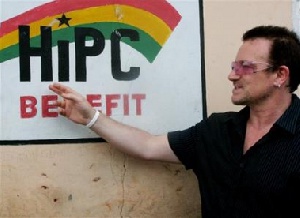General News of Monday, 10 July 2006
Source: Chronicle
Where Did Ghana HIPC Funds Go?
In 2001, the new Government of Ghana under the New Patriotic Party (NPP) decided to join the Heavily Indebted Poor Country (HIPC) Initiative which was the new framework for multilateral partnership for development under the Poverty Reduction Strategy Papers (PRSPs) process. From 2002 to 2005 Government received various funds under this arrangement for poverty alleviation. Have you ever asked how much funds accrued to the country under HIPC? Do you know which regions in Ghana benefited the most? Did the poor really benefit?
We now have an idea of how the Government of Ghana expended the funds from the Heavily Indebted Poor Country (HIPC) Initiative, which were ostensibly meant to reduce poverty in Ghana from 2002 to 2004! 'Where Did Ghana HIPC Funds Go?' is a critical analysis of 1,516 HIPC funded projects: it shows how the Government allocated HIPC funds and the extent to which poverty levels influenced the decision making process.
The main findings are as follows: - The HIPC funds were allocated without clearly stated and transparent guidelines. Disbursements were at the discretion of the Ministry of Finance and Economic Planning (MOFEP).
There was no specific budget for it.
- The MOFEP would authorise allocation of HIPC funds to Ministries, Departments and Agencies (MDAs) in response to applications which, had to be based on projects and programmes spelt out in the Ghana Poverty Reduction Strategy (GPRS).
- MDAs became the channels for spending HIPC funds. Though poverty and poverty alleviation measures are under the jurisdiction of District Assemblies (DAs), they were marginalized as their role subsumed under the Ministry of Local Government and Rural Development.
- Poverty or the degree that a region or district was poor compared to others, was not the criterion for allocating HIPC funds.
- Even within the context of the GPRS, factors such as 'population ratio' received more weight than poverty or the degree of it in the weighting system used in calculating the allocation of funds for poverty alleviation. This made the most populous regions, rather than the poorest regions, the greatest beneficiaries of HIPC funds.
- Allocation to Ministries which are responsible for sectors such as education, health, water, sanitation and agriculture declined as many more MDAs joined the scramble for HIPC funds. The most marginalized ministries were that of Women's and Children's Affairs, and Food and Agriculture.
- There was no evidence of a well articulated and holistic policy to cater for the needs of people with disability, who are among the most vulnerable.
- The three Northern Regions that are the poorest in the country received the fewest number of projects and programmes financed from the HIPC funds.
- Micro credit schemes became the short-cut policy instrument for wealth creation and employment among women and generally among small scale producers, especially small-holder farmers.
- The expenditure of HIPC funds was not done with the approval of Parliament, contrary to the relevant provisions of the Constitution.
- Nobody accounted for the expenditure of HIPC funds to Parliament, neither did Parliament exercise its monitoring and oversight powers to hold any MDA accountable for HIPC funds, or to ensure that those funds were spent with proper authorization
- In general, there was no strategic plan to tackle the problem of poverty within which certain targets are determined and prioritised. Poverty alleviation was reduced to the implementation of programmes and projects.
- The data on payment into HIPC funds account was sketchy; and data on expenditure of HIPC funds was often confusing, raising questions about the quality of information/data we obtained from official sources for this study.
The report - 'Where Did Ghana HIPC funds Go?' states emphatically that 'clearly the criterion for allocating HIPC funds was not the degree of poverty or need. It must have been something else which may have been implicit in the financial and administrative governance structures of the state. If the criterion of who gets a portion of HIPC funds, and why, was the degree of poverty, the three poorest regions of Northern Ghana might have received a much larger share of the funds than the data presented reveals".
The goal of the Ghana Poverty Reduction Strategy (GPRS), especially the HIPC Initiative, was to alleviate extreme poverty in line with the Millennium Development Goals (MDGs).
The findings raise questions about the country's ability to attain the MDGs given the fact that the disbursement of funds was distorted by a wide spectrum of interests within the state bureaucracy. The new Growth and Poverty Reduction Strategy (GPRS II - 2006 - 2009) promises to leverage more substantial resources for poverty reduction through avenues like the Youth Self Employment Fund, Millennium Challenge Account (MCA), Social Investment Fund (SIF) and the NEPAD School Feeding project. We must ensure that our national constitutional provision in the Declarative Principles of State Policy, which seeks to create a condition of balance in our national development agenda, is realised in GPRSII.
The following policy recommendations are therefore made:
- To correct these distortions and abuses, the District Assemblies (DAs), rather than the MDAs, should be the main channel for disbursing and applying poverty alleviation funds.
- The degree of poverty or deprivation should be weighted against all other variables in the weighting system used to determine the expenditure needs of regions and DAs within each region for poverty alleviation.
- The disbursement of all HIPC and other poverty alleviation funds, together with the formula for the allocation of such funds, should be approved by Parliament in the same way the District Assembly Common Fund is approved.
- The Auditor General should submit to Parliament for verification a report on all such funds, and all abuses and abusers must be corrected and sanctioned respectively in accordance with the law.
- Success in alleviating poverty as a human condition hinges on purposeful investment in human development. This requires prioritizing poverty alleviation programmes and projects in accordance with the Millennium Development Goals (MDGs) so that education, health and agriculture receive greatest attention.
- Poverty alleviation programmes and projects, for example in the areas of education, health, sanitation and employment should be redesigned to incorporate the special needs of the persons with disability.
Detailed record of HIPC receipts and expenditures, analysis of disbursements, findings and policy recommendations are contained in the report, 'Where did Ghana HIPC Funds Go? - Assessing HIPC Expenditures on Poverty Alleviation 2002 - 2004' published by The Social Enterprise Development (SEND) Foundation of West Africa (Ghana) in July, 2006. The report will be launched at the International Press Centre on 7th July, 2006.
We will also engage the Ministry of Finance and Economic Planning with the report to discuss the way forward in the disbursement of subsequent poverty alleviation funds in Ghana.











